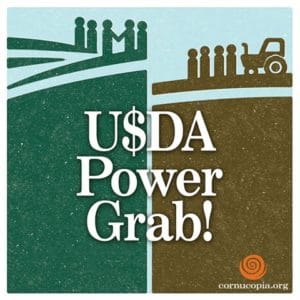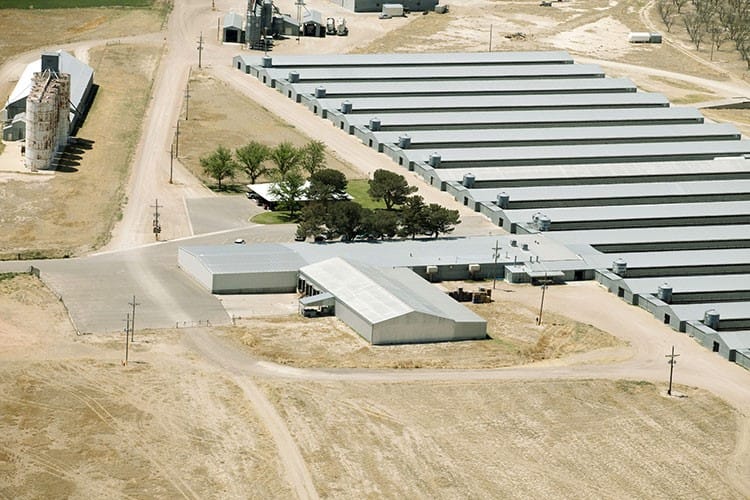Tuesday was the second day of the four-day National Organic Standards Board (NOSB) meeting in the La Jolla neighborhood of San Diego, California. At least twice a year the 15-member expert stakeholder panel meets around the country. The NOSB was created by Congress to represent the interests of the organic community, rather than allowing the industry to be dominated by corporate lobbyists, as is the custom in Washington.
 Corporate Patriots or Pandering for Profit?
Corporate Patriots or Pandering for Profit?
Unlike on Monday, on Tuesday there seemed to be less rhetoric from the opposing sides. Public interest groups, including Consumer Reports, Center for Food Safety, Beyond Pesticides, Organic Consumers Association, National Organic Coalition and The Cornucopia Institute, continued to articulate grave concern about what has commonly been referred to as a “power grab” by the USDA, stripping authority from the NOSB, and other related issues.
On the opposite end of the spectrum many professionals in the industry, most associated with the powerful Organic Trade Association, and including employees of multimillion-dollar organic certifiers, continued to praise the USDA and call for peace and harmony in the industry. The coded language was to tell the nonprofits to “sit down, shut up and clap louder.” The corporate-affiliated representatives might have a financial incentive to support the USDA, but all the NGOs are accountable to our members who passionately care about the integrity of the organic movement. We are not about to go away quietly.
Staff member Elizabeth Wolf defended Cornucopia’s role in the organic community stating that, while some might dislike the noise a watchdog makes barking in the middle of the night, it is a necessary function to maintain the foundational precepts of why we have worked so hard, together as a community, to nurture the organic movement.
Chicken Man… He’s Everywhere, He’s Everywhere!
Although there was much diverse testimony regarding the synthetic and non-organic materials that are up for review at this meeting, the discussion regarding removing supplemental methionine, a synthetic amino acid fed to poultry, was front and center.
The nonprofit community considers this an important adjunct to industrial-scale egg and meat production, considering it a “growth promoter.” In contrast, there was much testimony from egg industry representatives claiming that methionine is an important chemical that prevents chickens from becoming aggressive and injuring each other, and is essential to their nutrition.
Although the scientific analysis agrees that methionine is an important component in the birds’ diet, the question of whether poultry can obtain enough through natural supplements and dietary changes, versus feeding the synthetic amino acid, was part of the debate. The elephant in the room was the fact that the industry players did not discuss the fact that these birds, omnivores not vegetarians, were being systematically prevented, on giant factory farms, from exhibiting their natural instinctive behavior outdoors and enjoying a diverse diet of insects, worms and fauna. Also, the question of whether chickens should be allowed to eat organic meat scraps, as had always been the custom in raising poultry, was explored.
Who are these egg industry players? One expert testified on behalf of Herbruck’s, one of the largest players in the industry with an industrial-scale operation in Michigan licensed to hold over 1 million laying hens. He identified himself at the public meeting as a “private citizen” concerned with animal welfare and never even mentioned the name of the company that employs him.
 Herbruck’s (Michigan)
Herbruck’s (Michigan)
Two other giant agribusiness representatives identified themselves with “Coleman,” a long-term player in the “natural” and organic chicken industry. What the representatives failed to articulate is the fact that a number of years ago Coleman was purchased by the poultry giant Perdue. The volume of their organic poultry operation might be — might be — 5% of their total, but it’s likely less than 1%. And they want to influence the direction of the organic industry!
What do all of these egg industry representatives have in common? They all work for companies that have “split” production (producing both conventional and organic eggs). In fact, I think at every one of these companies conventional production is dominant with organics representing a minority, sometimes a minute minority, of their business. These are the folks that are going to set policy for the organic industry?
NOTE: The photos here of “farms” owned by Herbruck’s, in Michigan, and Chino Valley Ranchers, in Texas, were taken during our 2014 flyover investigation. Cornucopia members underwrote this aerial photography project, which culminated in our filing 14 formal legal complaints against (certified organic) “factory farm” across the country. None of the confinement poultry operations had any chickens outdoors, as the federal organic law clearly requires. For a full view of the photographic evidence, visit www.cornucopia.org/organic-factory-farm-investigation/.
 Chino Valley Ranchers (Texas)
Chino Valley Ranchers (Texas)
Secrecy and Subterfuge Continues As Part of Organic Governance
Under previous NOSB chairs there had been improvement in the long-standing problem of agribusiness representatives failing to fully identify themselves at these meetings. Unfortunately, except for the Perdue employees, a number of corporate lobbyists and consultants have been able to testify at this meeting without disclosing who their clients are. In one example, in the past, a pediatrician was allowed to register as a “private citizen” and testify on behalf of adding a gimmicky, and potentially dangerous, nutraceutical to organic infant formula and milk, when, at one time, he was actually retained by the dairy giant Dean Foods (now WhiteWave). We hope the current management of the NOP, and the current NOSB leadership, will refocus the need on transparency in terms of public commentary.
See No Evil
Subsequent to a number of prudent votes choosing not to approve new synthetics, one of the most disturbing events yesterday was the relisting, at sunset, of the synthetic food ingredient sodium acid pyrophosphate, also known as SAPP. The material is used as a leavening agent. It was supported to remain on the National List of approved substances by Hain Celestial Group and WhiteWave Foods (which indiscriminately endorsed every sunset material with the exception of boiler treatments). The giant food manufacturers were joined by two trade-lobby groups, the International Food Additives Council and the Organic Trade Association.
I’m sure organic consumers will feel comfortable that their interests are being protected by the NOSB when they listen to lobbyists from the International Food Additives Council (sardonic humor intended).
On the other side of the equation, three public interest groups — The Cornucopia Institute, Beyond Pesticides and Consumer Reports — all expressed their concerns about negative potential impacts on the environment, human health risks and the fact that safer alternatives exist for use as leavening agents, approved for use in organic food.
Here’s the rub: the NOSB member who led this debate claimed that the information on potential deleterious impacts came in at the last minute and couldn’t be considered based on current NOP instructions. So the board will revisit this concerning information five years from now when SAPP next comes up for sunset review.
Whoa, Nelly!
How many citizens could have their health impacted in the meantime? When evaluating these materials the board should be using the “precautionary principle” and erring on the side of caution rather than risking the health of eaters who look at the organic label as the last refuge of truly safe, natural food.
First, are the members of this board telling me that if Dr. Jonas Salk rose from the dead today and appeared at this meeting to testify, stating that SAPP was conclusively endangering the health of young children, and he had the scientific analysis to back up that claim, that they would nevertheless allow the use of a dangerous synthetic material in organic foods to continue for the next five years? All because the management at the NOP instructed them not to take pertinent information into consideration at this time?
The fact of the matter is that our colleagues, Dr. Terry Shistar at Beyond Pesticides and Charlotte Vallaeys at Consumer Reports, submitted scientific analysis and basis for the removal of this material, in 2014 and 2015, and again pursuant to the docket that was open prior to this meeting, indicating SAPP could cause kidney damage and calcium deposits and hormone-mediated harm to the cardiovascular system.
Today (Wednesday), NOSB member Zea Sonnabend said the Handling Subcommittee is going to prioritize looking at the health effects of accumulated phosphates in food between now and the next meeting. But that will be too late for SAPP! They just voted to bless it for another five years. It is not clear whether or not this could have been tabled until the next meeting (otherwise this should have been removed from the list).
This is a real stick in the eye to public interest groups like Beyond Pesticides, Consumer Reports and Cornucopia. Just like yesterday, when the OTA received preferential treatment denied Cornucopia, last fall, a certifier, acting as a corporate lobbyist, forwarded a letter, at the 11th hour, stating they needed a particular material (Tragacanth gum) that the NOSB appeared to be posed to remove from the list.
Did the NOSB deem their last-minute lobbying as “untimely” and deny its consideration, as they did with the erroneously described “last-minute” health concerns regarding SAPP? You can bet your bottom dollar they didn’t. They rolled out the red carpet and catered to the one agribusiness in the country requesting to keep that material on the list.
We demand equal respect for the advocacy efforts of researchers like Dr. Shistar at Beyond Pesticides, as that afforded industry trade-lobby groups and certifiers acting on behalf of their clients.
We will contact the board members and ask one of them who voted in favor of the material (the vote was 3 in favor of removing and 11 against), based on parliamentary procedure which governs the meetings, to move for reconsideration and a new vote. The health of organic consumers and the integrity of the organic label are at stake.
The long day of work, ending at 6:30 p.m., was rewarded by a gala reception sponsored by one of the largest organic certifiers, Quality Assurance International, at the Birch Aquarium at Scripps overlooking the Pacific Ocean. The food was incredible and the adult beverages flowed liberally. An organization like Cornucopia could never have afforded to sponsor such a gathering but our staff of five (a larger contingent than any of the other organizations, even the powerful OTA), thoroughly enjoyed the hospitality and sincerely thanks QAI, CCOF and the OTA for sponsoring the event and inviting all attendees to participate.
More news from the organic circus in San Diego later. In the interim, please see updates, in real-time, at www.cornucopia.org or on Cornucopia’s Twitter feed which you can sign up for on our website.
Mark A. Kastel
Codirector
The Cornucopia Institute

